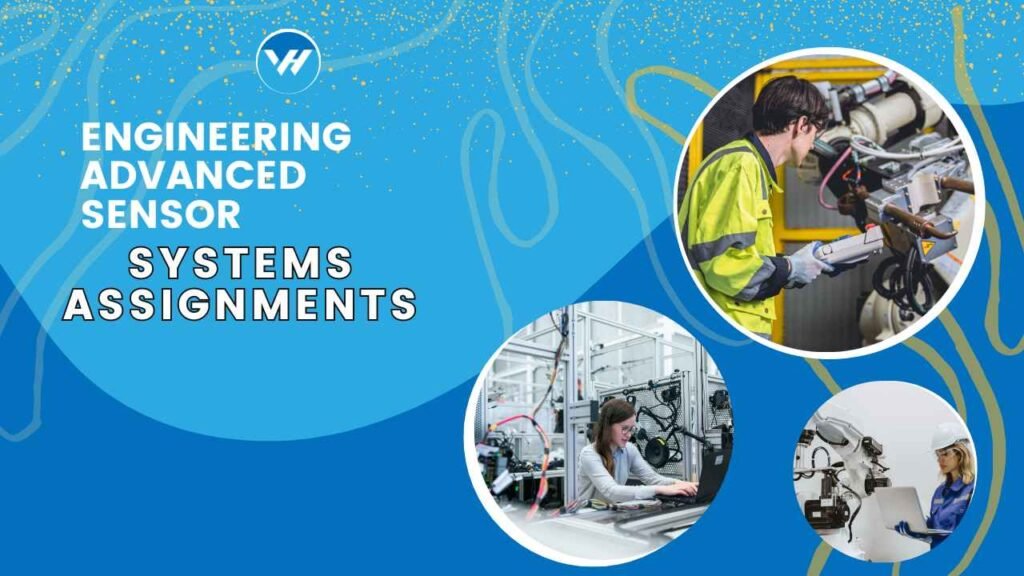Advanced sensor systems are at the heart of modern engineering, playing a crucial role in various industries from healthcare to automotive. These systems are designed to detect and measure physical phenomena, converting them into data that can be analyzed and acted upon. As the demand for smarter, more efficient technologies grows, so does the need for engineers to understand and develop advanced sensor systems. This article will guide you through everything you need to know about engineering advanced sensor systems assignments, providing insights, tips, and resources to help you succeed.

Table of Contents
ToggleUnderstanding Sensor Systems
Definition and Functionality
At its core, a sensor system comprises devices that detect changes in the environment and relay this information in the form of data. This data can then be used to monitor, control, or analyze the surrounding conditions. Sensor systems are essential for applications that require precise measurement and real-time data analysis.
Types of Sensor Systems
There are numerous types of sensor systems, each tailored to specific applications. Common types include temperature sensors, pressure sensors, motion sensors, and optical sensors. Advanced systems often integrate multiple types of sensors to achieve comprehensive monitoring capabilities.
Applications of Advanced Sensor Systems
Industrial Automation
In industrial settings, sensor systems are used to monitor machinery, track production processes, and ensure safety standards. They enhance efficiency by providing real-time data that can be used to optimize operations.
Healthcare and Medical Devices
From wearable health monitors to sophisticated imaging equipment, sensor systems are integral to modern medical devices. They help in diagnosing conditions, monitoring patient health, and even in performing minimally invasive surgeries.
Environmental Monitoring
Sensors are deployed to track environmental parameters such as air quality, water levels, and weather conditions. This data is crucial for environmental protection, disaster management, and climate research.
Automotive Industry
Modern vehicles are equipped with various sensors that enhance safety, performance, and comfort. These include parking sensors, collision detection systems, and engine monitoring sensors.
Consumer Electronics
From smartphones to smart homes, sensor systems are embedded in numerous consumer devices. They enable features like touch sensitivity, motion detection, and environmental awareness.
Key Components of Sensor Systems
Sensors
Sensors are the primary components that detect physical changes. They come in various forms, each designed to measure specific parameters like temperature, pressure, or light.
Signal Conditioning
This involves processing the raw signals from sensors to make them suitable for further analysis. It includes amplification, filtering, and analog-to-digital conversion.
Data Acquisition
Data acquisition systems collect and store the processed signals for analysis. They play a crucial role in ensuring the accuracy and reliability of the data.
Processing Units
The processing unit, often a microcontroller or computer, analyzes the data and performs necessary actions based on the results. It can trigger alarms, adjust controls, or store the data for future use.
Challenges in Sensor System Design
Sensitivity and Accuracy
Ensuring that sensors accurately detect and measure the desired parameters is a significant challenge. This often requires careful calibration and high-quality components.
Environmental Factors
Sensors must operate reliably under various environmental conditions, including extreme temperatures, humidity, and electromagnetic interference.
Power Consumption
Many sensor systems, especially those used in remote or portable applications, need to be energy-efficient to prolong battery life.
Data Management
Handling large volumes of data generated by sensor systems requires efficient storage, processing, and transmission solutions.
Recent Advances in Sensor Technology
MEMS Sensors
Microelectromechanical systems (MEMS) sensors are miniaturized devices that offer high performance and reliability. They are widely used in consumer electronics, automotive, and healthcare applications.
IoT Integration
The Internet of Things (IoT) has revolutionized sensor systems by enabling connectivity and communication between devices. IoT-integrated sensors provide real-time data access and remote monitoring capabilities.
Wireless Sensor Networks
Wireless sensor networks (WSNs) consist of spatially distributed sensors that communicate wirelessly to monitor and record environmental conditions. They are used in applications ranging from environmental monitoring to industrial automation.
Smart Sensors
Smart sensors combine sensing, processing, and communication capabilities within a single device. They can perform complex functions like data analysis and decision-making autonomously.
Sensor System Assignments: What to Expect
Typical Assignment Topics
Assignments may cover a wide range of topics, from designing specific sensor circuits to developing complete sensor networks. You might be asked to create a sensor for a particular application or analyze the performance of an existing system.
Practical vs. Theoretical Assignments
Practical assignments involve hands-on work, such as building and testing sensor systems, while theoretical assignments focus on concepts, design principles, and simulations.
Tools and Software Commonly Used
Software tools like MATLAB, LabVIEW, and various simulation programs are commonly used in sensor system assignments. Familiarity with these tools is essential for success.
How to Approach Sensor System Assignments
Understanding the Requirements
Carefully read the assignment brief to understand the objectives and deliverables. Clarify any doubts with your instructor to ensure you are on the right track.
Research and Literature Review
Conduct thorough research to gather information on the topic. Review academic papers, textbooks, and online resources to build a solid foundation of knowledge.
Designing and Simulating Sensor Systems
Use design and simulation tools to create and test your sensor system. This step involves iterative testing and refinement to achieve the desired performance.
Testing and Validation
Validate your design by comparing simulation results with theoretical predictions. Ensure that your sensor system meets the required specifications and operates reliably under various conditions.
Common Mistakes to Avoid
Ignoring Environmental Variables
Failing to consider environmental factors can lead to inaccurate measurements and unreliable performance. Always account for these variables in your design.
Overlooking Calibration
Calibration is crucial for ensuring sensor accuracy. Neglecting this step can result in significant errors in data measurement.
Inadequate Documentation
Proper documentation is essential for understanding and replicating your work. Ensure that your reports are clear, detailed, and well-organized.
Resources for Sensor System Assignments
Textbooks and Academic Papers
Standard textbooks and scholarly articles provide in-depth knowledge and insights into sensor system design and applications.
Online Courses and Tutorials
Online platforms like Coursera, edX, and YouTube offer courses and tutorials on sensor systems, covering both theoretical and practical aspects.
Virtual Help Services
Virtual Help provides a platform where you can find expert tutors and get assistance with your assignments. Their services are accessible through an iOS and Android app, making it convenient to get help anytime, anywhere.
Benefits of Using Virtual Help for Assignments
Finding Expert Tutors
Virtual Help connects you with experienced tutors who can guide you through complex assignments and help you understand difficult concepts.
Getting Assignment Help Anytime, Anywhere
With the Virtual Help app, you can get assistance whenever you need it, whether you’re at home or on the go.
Access to a Wide Range of Resources
The platform offers a variety of resources, including study materials, sample assignments, and interactive sessions with tutors.
Virtual Help Platform Overview
Introduction to the Platform
Virtual Help is an online service that connects students with tutors and provides assignment help. It is accessible through both iOS and Android apps.
Features and Benefits
The platform offers personalized tutoring, assignment assistance, and a vast library of resources. It is designed to help students succeed in their academic endeavors.
How to Get Started
Download the Virtual Help app, create an account, and start exploring the services available. You can search for tutors, request help with assignments, and access study materials.
Future Trends in Sensor Systems
Advances in AI and Machine Learning
Integrating AI and machine learning with sensor systems can enhance data analysis and decision-making capabilities, leading to smarter and more autonomous systems.
Enhanced Connectivity with 5G
The rollout of 5G technology will enable faster and more reliable communication between sensors, paving the way for more advanced and integrated sensor networks.
Sustainable and Eco-Friendly Sensors
There is a growing emphasis on developing sensors that are environmentally friendly and sustainable, using materials and designs that minimize ecological impact.
Conclusion
Engineering advanced sensor systems is a dynamic and exciting field with applications across various industries. By understanding the key components, challenges, and recent advances, you can approach sensor system assignments with confidence. Utilize resources like textbooks, online courses, and Virtual Help to enhance your learning and successfully complete your assignments. The future of sensor systems is bright, with innovations in AI, 5G, and sustainability driving the next wave of advancements. Keep exploring, stay curious, and embrace the opportunities that lie ahead.
FAQs
- What are the basic components of a sensor system?
- The basic components include sensors, signal conditioning, data acquisition, and processing units.
- How do MEMS sensors differ from traditional sensors?
- MEMS sensors are miniaturized devices that offer high performance and reliability, often used in compact and portable applications.
- What are the benefits of using wireless sensor networks?
- Wireless sensor networks provide flexibility, ease of installation, and the ability to monitor large areas without extensive wiring.
- How can Virtual Help assist with sensor system assignments?
- Virtual Help connects you with expert tutors, provides assignment assistance, and offers a variety of study resources through their app.
- What are the future trends in sensor technology?
- Future trends include advances in AI and machine learning, enhanced connectivity with 5G, and the development of sustainable and eco-friendly sensors.





